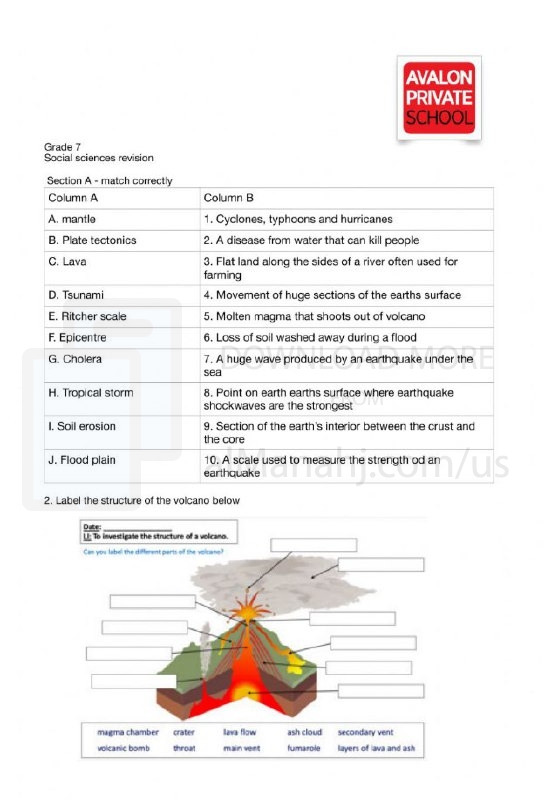| You are here: Almanahj Website ⇒ American curriculum ⇒ 7th Grade ⇒ Geology ⇒ Term 1 | ||
|---|---|---|
Worksheet about Disasters and earth structure | ||
|---|---|---|
| Subject: Geology | ||
| 7th Grade | ||
| Term 1 | ||
| Year: 2023/2024 | ||
| Size: 351.4KB | ||
| Number of clicks: 233 | ||
| Publish date:December 04, 2023 | ||
| Added by: Eman | ||
| Last download date: 2024-09-13 07:46:49 | By: theodor george branda | |
| File info: Disasters can have a significant impact on Earth's structure, both in terms of the immediate effects they cause and the long-term changes they may induce. Here are some examples of how disasters can interact with Earth's structure: 1. Earthquakes: Earthquakes occur when there is a sudden release of energy in the Earth's crust, usually due to tectonic plate movements. They can result in severe shaking of the ground, causing structures to collapse and triggering landslides. Strong earthquakes can also generate tsunamis if they occur under the ocean. While earthquakes do not directly change Earth's structure, they can cause significant damage to the built environment and alter the landscape. 2. Volcanic Eruptions: Volcanic eruptions involve the release of molten rock, volcanic gases, and ash from the Earth's interior onto its surface. Volcanic activity occurs primarily at plate boundaries or hotspots. Eruptions can lead to the formation of new landforms, such as volcanic mountains and lava flows. They can also cause ashfall, pyroclastic flows, and lahars (mudflows) that can damage infrastructure and alter the topography of affected areas. 3. Landslides: Landslides occur when masses of rock, soil, or debris move downhill due to gravity. They can be triggered by various factors, including heavy rainfall, earthquakes, or human activities. Landslides can alter the shape of the land, bury structures, and block rivers or roads. 4. Sinkholes: Sinkholes are depressions or cavities that form on the Earth's surface when underlying rock or soil collapses. They can be caused by natural processes, such as dissolution of soluble rocks (e.g., limestone) or the removal of underground water. Sinkholes can cause damage to infrastructure and homes, particularly in areas with susceptible geology. 5. Impact Craters: Impact craters are formed when celestial objects, such as asteroids or comets, collide with the Earth's surface. These high-energy impacts can excavate large craters and cause widespread destruction. While major impact events are rare, they have significantly impacted Earth's history, including the extinction of the dinosaurs. It's important to note that while disasters can affect Earth's structure and surface, they are part of natural processes that have shaped our planet over billions of years. Human activities can also contribute to the severity and frequency of some disasters, such as through deforestation, urbanization in vulnerable areas, or climate change. Understanding the interactions between disasters and Earth's structure is crucial for mitigating their impacts and promoting resilience in affected regions. | ||
| Downloading link Worksheet about Disasters and earth structure |
|---|
|
1701670415.pdf
The file is being prepared for download
|
| File images |
|---|
 |